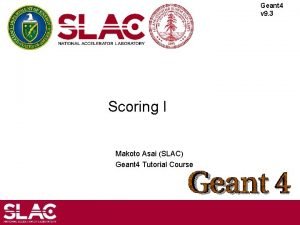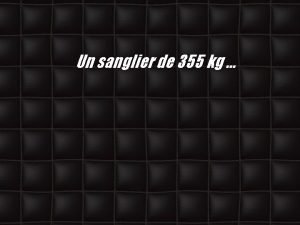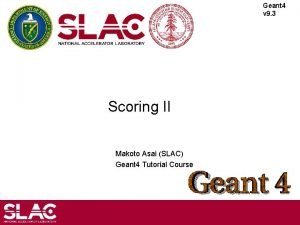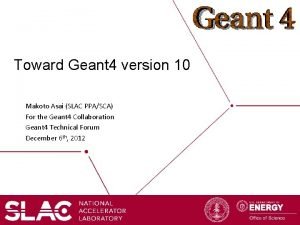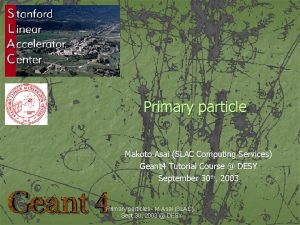Geant 4 v 9 3 Scoring I Makoto














- Slides: 14

Geant 4 v 9. 3 Scoring I Makoto Asai (SLAC) Geant 4 Tutorial Course

Contents • Retrieving information from Geant 4 • Command-based scoring This talk • Add a new scorer/filter to command-based scoring • Define scorers in the tracking volume Next talk • Accumulate scores for a run Scoring I - M. Asai (SLAC) 2

Geant 4 v 9. 3 Retrieving information from Geant 4

Extract useful information • Given geometry, physics and primary track generation, Geant 4 does proper physics simulation “silently”. – You have to add a bit of code to extract information useful to you. • There are three ways: – Built-in scoring commands This talk • Most commonly-used physics quantities are available. – Use scorers in the tracking volume • Create scores for each event Next talk • Create own Run class to accumulate scores – Assign G 4 VSensitive. Detector to a volume to generate “hit”. • Use user hooks (G 4 User. Event. Action, G 4 User. Run. Action) to get event / run summary • You may also user hooks (G 4 User. Tracking. Action, G 4 User. Stepping. Action, etc. ) – You have full access to almost all information – Straight-forward, but do-it-yourself Scoring I - M. Asai (SLAC) 4

Geant 4 v 9. 3 Command-based scoring

Command-based scoring • • Command-based scoring functionality offers the built-in scoring mesh and various scorers for commonly-used physics quantities such as dose, flux, etc. – Since this functionality is still preliminary, it is not provided by default. – We appreciate user’s feedbacks. To use this functionality, access to the G 4 Scoring. Manager pointer after the instantiation of G 4 Run. Manager in your main(). #include “G 4 Scoring. Manager. hh” int main() { G 4 Run. Manager* run. Manager = new G 4 Run. Manager; G 4 Scoring. Manager* scoring. Manager = G 4 Scoring. Manager: : Get. Scoring. Manager(); … All of the UI commands of this functionality is in /score/ directory. /examples/extended/run. And. Event/RE 03 Scoring I - M. Asai (SLAC) 6

/example/extended/run. And. Event/RE 03 Scoring I - M. Asai (SLAC) 7

Define a scoring mesh • To define a scoring mesh, the user has to specify the followings. 1. Shape and name of the 3 D scoring mesh. Currently, box is the only available shape. • Cylindrical mesh also available as a beta-release. 2. Size of the scoring mesh. Mesh size must be specified as "half width" similar to the arguments of G 4 Box. 3. Number of bins for each axes. Note that too many bins causes immense memory consumption. 4. Optionally, position and rotation of the mesh. If not specified, the mesh is positioned at the center of the world volume without rotation. # define scoring mesh /score/create/box. Mesh_1 /score/mesh/box. Size 100. cm /score/mesh/n. Bin 30 30 30 • The mesh geometry can be completely independent to the real material geometry. Scoring I - M. Asai (SLAC) 8

Scoring quantities • A mesh may have arbitrary number of scorers. Each scorer scores one physics quantity. – energy. Deposit * Energy deposit scorer. – cell. Charge * Cell charge scorer. – cell. Flux * Cell flux scorer. – passage. Cell. Flux * Passage cell flux scorer – dose. Deposit * Dose deposit scorer. – n. Of. Step * Number of step scorer. – n. Of. Secondary * Number of secondary scorer. – track. Length * Track length scorer. – passage. Cell. Current * Passage cell current scorer. – passage. Track. Length * Passage track length scorer. – flat. Surface. Current * Flat surface current Scorer. – flat. Surface. Flux * Flat surface flux scorer. – n. Of. Collision * Number of collision scorer. – population * Population scorer. – n. Of. Track * Number of track scorer. – n. Of. Terminated. Track * Number of terminated tracks scorer. /score/quantitly/xxxxx <scorer_name> Scoring I - M. Asai (SLAC) 9

• List of provided primitive scorers Concrete Primitive Scorers ( See Application Developers Guide 4. 4. 6 ) – Track length • G 4 PSTrack. Length, G 4 PSPassage. Track. Length – Deposited energy • G 4 PSEnergy. Depsit, G 4 PSDose. Deposit, G 4 PSCharge. Deposit – Current/Flux • G 4 PSFlat. Surface. Current, G 4 PSSphere. Surface. Current, G 4 PSPassage. Current, G 4 PSFlat. Surface. Flux, G 4 PSCell. Flux, G 4 PSPassage. Cell. Flux – Others • G 4 PSMin. Kin. EAt. Generation, G 4 PSNof. Secondary, G 4 PSNof. Step Surface. Flux : Cell. Flux : Surface. Current : Sum up 1/cos(angle) of Sum of L / V of Count number of injecting particles at defined surface in the geometrical cell. at defined surface. angle L : Total step length in the cell. V : Volume Scoring I - M. Asai (SLAC) 10

Filter • Each scorer may take a filter. – charged * Charged particle filter. – neutral * Neutral particle filter. – kinetic. Energy * Kinetic energy filter. /score/filter/kinetic. Energy <fname> <e. Low> <e. High> <unit> – particle * Particle filter. /score/filter/particle <fname> <p 1> … <pn> – particle. With. Kinetic. Energy * Particle with kinetic energy filter. /score/quantity/energy. Deposit e. Dep /score/quantity/n. Of. Step. Gamma /score/filter/particle gamma. Filter gamma Same primitive scorers /score/quantity/n. Of. Step. EMinus with different filters /score/filter/particle e. Minus. Filter emay be defined. /score/quantity/n. Of. Step. EPlus /score/filter/particle e. Plus. Filter e+ /score/close Close the mesh when defining scorers is done. Scoring I - M. Asai (SLAC) 11

Drawing a score • Projection /score/draw. Projection <mesh_name> <scorer_name> <color_map> • Slice /score/draw. Column <mesh_name> <scorer_name> <plane> <column> <color_map> • Color map – By default, linear and log-scale color maps are available. – Minimum and maximum values can be defined by /score/color. Map/set. Min. Max command. Otherwise, min and max values are taken from the current score. Scoring I - M. Asai (SLAC) 12

Write scores to a file • • Single score /score/dump. Quantity. To. File <mesh_name> <scorer_name> <file_name> All scores /score/dump. All. Quantities. To. File <mesh_name> <file_name> By default, values are written in CSV. By creating a concrete class derived from G 4 VScore. Writer base class, the user can define his own file format. – Example in /examples/extended/run. And. Event/RE 03 – User’s score writer class should be registered to G 4 Scoring. Manager. Scoring I - M. Asai (SLAC) 13

More than one scoring meshes • • You may define more than one scoring mesh. – And, you may define arbitrary number of primitive scorers to each scoring mesh. Mesh volumes may overlap with other meshes and/or with mass geometry. A step is limited on any boundary. Please be cautious of too many meshes, too granular meshes and/or too many primitive scorers. – Memory consumption – Computing speed Scoring I - M. Asai (SLAC) 14



